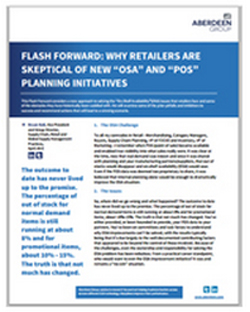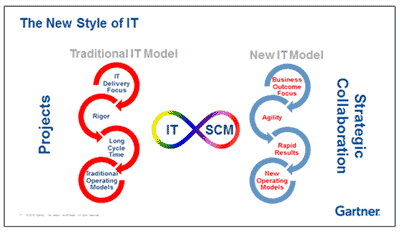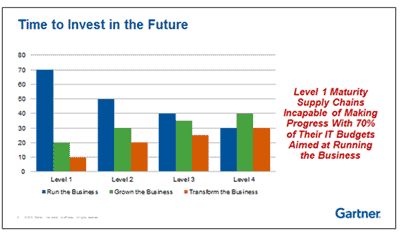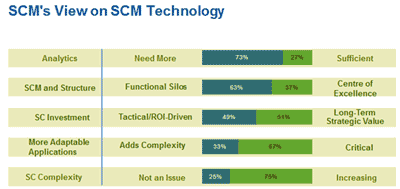 |
June 11, 2015 - Supply Chain Flagship Newsletter |
 |
| FEATURED SPONSOR: JDA |
||
 |
||
Download the White Paper: Flash Forward – Why Retailers are Skeptical of New 'OSA' and 'POS' Planning Initiatives |
 |
|
||||||||||||||||||||||||||||||||||||||||||||||||||||||||||||||||||||||||||||||||||||||||||||||||
Released several years ago, the original model had four levels, but now has expanded to five. The basic concept has been spun out to similar maturity models for Sales & Operations Planning, Logistics and I believe a few more areas. That maturity model is important for this year's Gartner-SCDigest research because survey respondents were asked to self-rate themselves as being in one of those five levels, and then many of the responses were analyzed based on that segmentation. If you aren't familiar with that DDVN model, the five levels are: Level 1 - React (business unit focused, often misaligned or siloed objectives); Level 2 - Anticipate (some supply chain functional performance improvements over Level 1); Level 3 - Integrate (integrated, cross functional supply chain decision-making); Level 4 - Collaborate (profitable demand-driven fulfillment through internal and some external collaboration); and Level 5 - Orchestrate (profitable shared value creation through innovation across internal/external networks). Gartner will tell you very few if any companies are really at level 5. For this year's survey purpose, one company placed itself at that level out of some 400 total. Here is a graphic of the maturity levels across different attributes if you are interested: Gartner's Demand Driven Maturity Model. In this survey, 20% said they were Level 1, 44% Level 2, 31% Level 3 and 5% Level 4. The study analysis exists now basically just as a powerpoint presentation. Over the next few months, a series of Gartner research notes based on the data will be generated by various analysts. The focus of this year's report pivoted more strongly towards supply chain IT versus operations, which Klappich said had become a bit boring over the years, and that change makes a big difference in the analysis. Getting a little ahead of myself, I liked Gartner's breakdown of the relationship between the supply chain organization and IT as being in one of four modes, ranging from "strategic" collaboration at one end and "contentious" at the other. In the two in-between categories, Gartner nicely calls out one category it calls "project-focused," meaning IT is sort of like an internal service for hire - and there are still a lot of companies where that is how it continues to work. Which led to the graphic below, which compares what Gartner says is the old supply chain IT model to a new more enlightened one. In the old model, IT is mostly focused on "delivery" of technology, on-time and on-budget. In the new model, the focus transitions first to adoption, not just delivery, but more importantly business outcomes created from the new technology, not the usual IT metrics.
I believe this is spot on. Early on in the presentation, Gartner offers this chart, which shows the share of IT spend going to different types of projects by how respondents classified their companies in the DDVN maturity model.
As can be seen, higher maturity companies spend far greater share of their IT money on programs related to growing the company and transformational efforts than do less mature ones, which spend much higher percentages on just maintaining/running the business and traditional cost focused projects. I had a short but interesting discussion with Garner's Eschinger on this, and he repeated the analogy used in the report of a black hole out in space, which in supply chain terms he says are very tactical, cost-focused initiates. Meaning, for many companies, no matter how hard they try to more balance those projects with ones more focused on innovation and growth, the gravitational pull of lower costs keeps pulling most resources back into that kind of work. This is actually kind of an important point, and one worth pondering for a second. A discussion related to this arose during a presentation I made to JDA Software's Demand Optimization Council meeting in late April on supply chains strategy, where I made the point that a supply chain strategy needs to well align with a company's overall strategy for growth and innovation. The problem, meeting attendees said, was that while that is all well and good, it is too hard to measure results on that strategic/growth side of the equation. So you are left with something that is pretty easy to measure these days, and that is cost. So there you are. More on this someday soon. Wrapping up Gartner report highlights, the chart below summarizes results from a series of questions that offered respondents a binary set of choices. So, for example, 73% believe their companies need more supply chain analytics, while just 27% say what they have now is sufficient. Does more agile supply chain software actually add complexity, I suppose on the belief all that tweaking and reconfiguring over time is a lot harder than just sticking with what you've got? Anyways, 33% think so, the survey found.
Ok, I am out of room. My recommendation to Gartner is they bring back some of the more operations focused data and observations next year. Will appreciate your help in November when we start this up for 2016. Any reaction to the highlights of the 2015 Gartner supply chain study? Where do you come down on supply chain IT spend for core cost reduction versus growth and innovation? Let us know your thoughts at the Feedback button or section below.
|
|||||||||||||||||||||||||||||||||||||||||||||||||||||||||||||||||||||||||||||||||||||||||||||||||
|
|||||||||||||||||||||||||||||||||||||||||||||||||||||||||||||||||||||||||||||||||||||||||||||||||
|
|||||||||||||||||||||||||||||||||||||||||||||||||||||||||||||||||||||||||||||||||||||||||||||||||
|
|
|
YOUR FEEDBACK
We received some modest Feedback on our article on Kroger being the latest retailer to begin a program to hire disabled workers in a distribution center, but wondering whjy more retalers haven't initiated these programs after success at Walgreens and a few others. Some of the Feedback from our partners over a RetailWire.
Feedback on Disabled Worker Programs in Retail DCs:
There are more risks in the distribution center than in the stores. The key is that Kroger has been so aggressive in getting disabled workers into the stores. I shop at Frys, a Kroger arm in Arizona, and have great relations with the many disabled employees at our favorite Frys store. It's great to see and they're dedicated workers who love what they do - and we all ignore their challenges.
Tom Redd
|
||
The article does a good job of summing up most of the reasons but avoids the one key reason: discrimination. People feel uncomfortable around people who have disabilities. As the article says, and research has shown, employees with disabilities if hired and trained properly can be real assets. Mel Kleiman Humetrics
|
||
At the risk of stating the obvious: because distribution center (warehouse) work is physically demanding, and often dangerous, and the list of disabilities which cannot be accommodated is long (visual impairment, paralysis, neuromuscular conditions, etc.). Walgreens and Kroger are to be applauded - even if the modest claim of serving their self-interest is true - but I'd be cautious about stereotyping (even a seemingly positive one).
I suspect the (perceived) greater reliability is largely due to more rigorous screening.
Anonymous |
||
I believe there is just a lot of mystery here to most distribution companies and retailers. You are afraid of what you don't know.
In addition, I think these iniatives are perhaps obviously best suited for DCs with a lot of piece picking, which is true in many/most retail DCs, but perhaps why the move has not apread to other sectors.
But in the end, these programs seem to be having success, so more companies should be looking at them.
Christian Wolfe Long Island, NY
|
SUPPLY CHAIN TRIVIA ANSWER
Q: In $billions, what was the level of US imports of goods from China in 2000 and then in 2014?
A: 2000: roughly $100 billion; 2014: $466.7 billion. US exports to China have grown from $16 billion to $123.6 billion over the same period - a faster growth rate, actually, but still far short in terms of value.
| © SupplyChainDigest™ 2003-2015. All Rights Reserved. SupplyChainDigest PO Box 714 Springboro, Ohio 45066 |
POWERED BY: XDIMENSION
|











